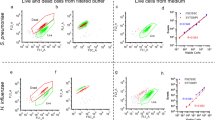Abstract
We studied the usefulness of flow cytometry for detection of vancomycin resistance in Enterococcus faecalis by direct binding of commercially available fluorescent vancomycin to cells obtained from culture. The cells were stained with Vancomycin@FL, sonicated and additionally stained with propidium iodide (PI). Regarding to inductive mechanism of vanA-mediated vancomycin resistance, resistant reference strain was also pre-incubated with vancomycin. PI staining divided cells into two subpopulations. There were significantly lower mean FL1 fluorescence values and mean fluorescence per particle (FL1/FSC) in reference vancomycin-resistant strain than in reference and clinical strains sensitive to this antibiotic. Pre-incubation with vancomycin of vancomycin resistant enterococci strain modified Vancomycin@FL binding, however, cells remained easy to differ. We have demonstrated new, quick and sensitive method for detection of vancomycin resistant strains of E. faecalis. The study proved possibility of detection of vancomycin resistance caused by presence of vanA gene by staining cells with Vancomycin@FL. Flow cytometry approach study of E. faecalis vancomycin resistance by detection of Vancomycin@FL binding to the bacterial cells.




Similar content being viewed by others
References
Sood S, Malhotra M, Das BK, Kapil A (2008) Enterococcal infections and antimicrobial resistance. Indian J Med Res 128:111–121
Murray BE (1998) Diversity among multidrug-resistant enterococci. Emerg Infect Dis 4:37–47
Seedat J, Zick G, Klare I, Konstabel C, Weiler N, Sahly H (2006) Rapid emergence of resistance to linezolid during linezolid therapy of an Enterococcus faecium infection. Antimicrob Agents Chemother 50:4217–4219
Werner EG, Coque TM, Hammerum AM, Hope R, Hryniewicz W, Johnson A, Klare I, Kristinsson KG, Leclercq R, Lester CH, Lillie M, Novais C, Olsson-Liljequist B, Peixe LV, Sadowy E, Simonsen GS, Top J, Vuopio-Varkila J, Willems RJ, Witte W, Woodford N (2008) Emergence and spread of vancomycin resistance among enterococci in Europe. Euro Surveill 13:19046
Lee DK, Kim Y, Park KS, Yang JW, Kim K, Ha NJ (2007) Antimicrobial activity of mupirocin, daptomycin, linezolid, quinupristin/dalfopristin and tigecycline against vancomycin-resistant enterococci (VRE) from clinical isolates in Korea (1998 and 2005). J Biochem Mol Biol 40:881–887
Patel R (2003) Clinical impact of vancomycin-resistant enterococci. J Antimicrob Chemother 51:13–21
Werner G, Gfrörer S, Fleige C, Witte W, Klare I (2008) Tigecycline-resistant Enterococcus faecalis strain isolated from a German ICU patient. J Antimicrob Chemother 61:1182–1183
D’mello D, Daley AJ, Rahman MS, Qu Y, Garland S, Pearce C, Deighton MA (2008) Vancomycin heteroresistance in bloodstream isolates of Staphylococcus capitis. J Clin Microbiol 46:3124–3126
Jarzembowski T, Wiśniewska K, Jóźwik A, Bryl E, Witkowski J (2008) Flow cytometry as a rapid test for detection of penicillin resistance directly in bacterial cells in Enterococcus faecalis and Staphylococcus aureus. Curr Microbiol 57:167–169
Jarzembowski T, Wiśniewska K, Jóźwik A, Witkowski J (2009) Heterogeneity of methicillin-resistant Staphylococcus aureus strains (MRSA) characterized by flow cytometry. Curr Microbiol 59:78–80
National Committee for Clinical Laboratory Standards (2002) Methods for dilution antimicrobial susceptibility tests for bacteria that grow aerobically, 5th edn. Approved standards M7–A5. National Committee for Clinical Laboratory Standards, Wayne, PA
Alvarez-Barrientos A, Arroyo J, Canton R, Nombela C, Sanchez-Perez M (2000) Application of flow cytometry to clinical microbiology. Clin Microbiol Rev 13:167–195
Tomita H, Ike Y (2008) Genetic analysis of the enterococcus vancomycin resistance conjugative plasmid pHT_: identification of the region involved in cell aggregation and traB, a key regulator gene for plasmid transfer. J Bacteriol 190:7739–7753
Author information
Authors and Affiliations
Corresponding author
Rights and permissions
About this article
Cite this article
Jarzembowski, T., Jóźwik, A., Wiśniewska, K. et al. Flow Cytometry Approach Study of Enterococcus faecalis Vancomycin Resistance by Detection of Vancomycin@FL Binding to the Bacterial Cells. Curr Microbiol 61, 407–410 (2010). https://doi.org/10.1007/s00284-010-9628-z
Received:
Accepted:
Published:
Issue Date:
DOI: https://doi.org/10.1007/s00284-010-9628-z




